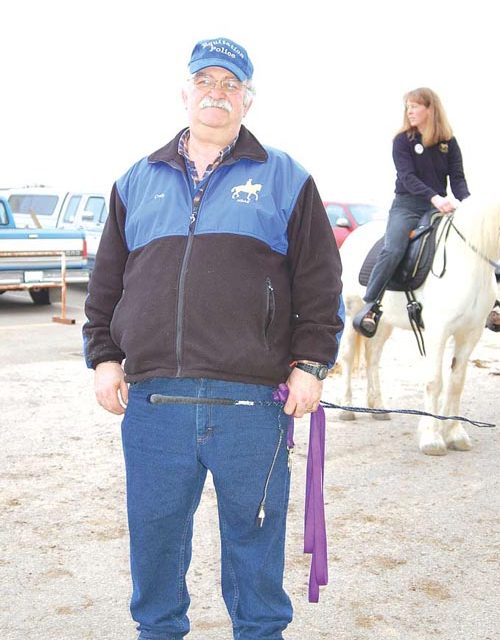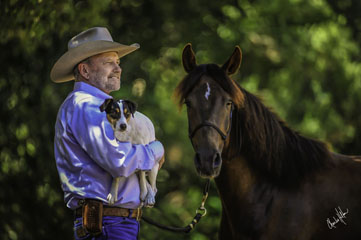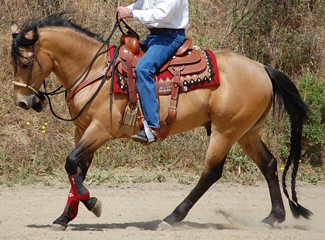Historically the lateral movements, including half-pass and shoulder-in (which we discussed in our last article), evolved during the Renaissance. The early literature includes descriptions of lateral work in treatises by the Neopolitan masters Federico Grisone and Gianbattista Pignatelli. Lateral work is also described by the 16th century French trainer Antoine de Pluvinel and by the 17th century Englishman William Cavendish, Duke of Newcastle.
One of the more difficult lateral movements is the half-pass, which, depending on where it is executed in the arena, has several names. When it’s executed on a circle, the half-pass is called haunches in, and in training the half-pass is the antagonist to the shoulder-in.
The half-pass is difficult for the rider, not because it requires intellectual brilliance but because it requires real tact. Rather than leaving the movement for later the real understanding of tact should be taken on first, not as an afterthought in the rider’s education. But the tact must be clearly understood to have value — and it is very hard in a brief article to convey this tactile concept.
The rein aids
Before we start, let’s quickly revisit the rein aids.
Indirect rein. A small, circular action toward the mouth (“small” meaning a circle about the size of a grain of sand) accompanied by a clucking, kissing, or whip tapping to create energy will result in the horse moving his shoulders away from the handler.
Direct rein. If the small circle is drawn away from the horse’s mouth, the effect is a direct rein. The effect of the direct rein is that the haunches move away.
Half-halt. The half-halt is the small circle toward the nose and up, indicating lift, and the educated horse will elevate his head in response.
The half-pass
The half-pass is a lateral movement into the bend of the horse. In hand, the horse is bent away from the handler and moves away from her, as illustrated in the drawing here.
The handler’s outside hand is primary. In this illustration, the rein on the outside is in the right hand. The left hand gently holds the secondary rein with the arm in a comfortable position. Drawing slightly down on the secondary rein will increase the touch on the inside rein, while letting up on it will decrease the touch. Again, the touch is so light that the horse’s mouth doesn’t even “crinkle” as a result of the action of the bit. To encourage the horse to bend his neck away the handler yields the bit hand while taking up slack with the secondary hand.
Note that we did not say “pull the horse’s head away from you” or “push the horse’s head away.” The configuration of the half-pass is easy to disrupt. The unfortunate reality of the human mind is that it’s much easier to try to force things than it is to learn to ask for them.
The horse must hold himself in the bend. If you try to use a pulley system to keep him in position you will interfere with his autonomy and balance, and you will lose the benefit of the movement. If the handler pulls on the primary rein she will change the bend of the horse. If she pulls on the secondary rein she will change the direction of travel. The handler only indicates her intention with the primary hand and encourages the bend and creates impulsion with the secondary hand. Pulling is defined by the horse, not by the handler. You may think you’re being very light but the horse reports the reality of his experience.
The handler can walk sideways, as shown, or can face the rear and walk backwards. The term “outside” means outside the bend of the horse, and “inside” means inside the bend.
Asking for a half-pass. Let’s start with the primary rein, which in the half-pass is the outside rein. The primary hand “sets the rider’s intention” through the use of the aids, direct rein, indirect rein, and half-halt.
The secondary rein, while it does not direct the action, encourages the bend and creates the impulsion. The handler has taken up the slack in the secondary rein, so that the horse holds himself bent away from the handler. The bend is suggested, not created, by the contact, so there is the sensation of touch in the left hand but not pressure.
If the horse chews the bit you’ll know it but the left hand should feel no more than the weight of the rein and the gentle reactions of the horse’s mouth. When the horse steps into the movement, the conscious handler will feel a sensation of a slight tug on the secondary rein. If you gently give with that movement, you make it easy for the horse to take that step. This sort of agreement creates an impulsive effect.
In hand the horse moves into his bend with his neck bent away from the handler. The primary hand gently directs the movement. In an ideal half-pass it’s the horse that holds the bend and not the rider. The secondary hand encourages the bend without forcing it, while following the movement like a dance partner — and by slightly amplifying that movement the secondary hand creates impulsion.
The rider or handler must practice frequent “descents of the aids,” which is to say, the moment the horse is doing what you ask, stop asking! Relax, follow, and enjoy the movement so that the horse carries himself through it.
Half-pass type movements, with the horse bent to the direction that he is moving, are more difficult for the novice rider to grasp intellectually and tactilely. With the neck bent, say, to the right and the left hand primary the slightest overuse of the primary hand or the release of the secondary hand will result in the horse losing his bend.
“No” means “no” in relationships with horses just as it does with people. Be polite, and work gently at the edges rather than forcing the movement. Just like in stretching for people, you only cause damage by forcing. Where the value lies is in the pleasure of the dance, not in the extremity of the movement.
When you work a horse in hand, you can’t use your legs to hide mistakes so you are presented with a clear opportunity to learn tact. You have to learn to “flirt” with the bit hand and to “dance” with the secondary hand.
No force is needed, and the lighter your touch the better.
Using the direct rein and the half-halt moves the weight to the forward outside leg of the horse. Employing the indirect rein and the half-halt moves the weight back to the rear inside leg. A careful balancing of the direct and indirect rein with the half-halt will produce a transfer of the weight towards the horse’s center. When you move the weight to the center, an interesting thing happens: the horse starts to move diagonally forward into the bend. This diagonal movement through the bend is called the half-pass. Adding more direct rein in this configuration increases the angle away from the handler; more indirect rein decreases the angle.
The half-pass, or haunches-in type of movement, is the antagonist of the shoulder-in. Whereas the shoulder-in has a submissive aspect to it, the haunches-in is a position in which the movement is more of a dominating posture.
Among the important things about movement into the bend is that this is one of the most effective ways to control the horse. Because there’s an anatomical limit to the bend, the bend itself forms a joint lock which is more systemic than that which occurs in a shoulder-in. The only evasion that is possible for the horse is to invert the bend. The handler, keeping the reins properly adjusted, makes it difficult for the horse to do this.
The rider’s outside, primary hand controls the displacement of weight on the left diagonal, because the horse is bent to the right. When the rider moves the weight to the center of that diagonal pair of legs, the horse moves into the bend, and that’s the half-pass.
The half-pass causes a kind of collection by the way that the horse moves. The horse is pressed into its own bend. The technical difficulty is to maintain the curve of the neck with the inside rein without it becoming primary — while at the same time that rein functions as a secondary rein.
Moving the horse into the bend this way can become an effective way of dominating him. As in all training, movements work in pairs. The half-pass type of movement and the shoulder-in type of movement are antagonists and need to be balanced. That is, you do both movements equally. This can be very hard with a green horse and a green rider. The shoulder-in is quite naturally easier and does not present anywhere near the technical difficulties of the half-pass. On the other hand, by shining a spotlight on any mistakes, the half-pass teaches the novice rider tact in the hand, and it teaches the concept of giving with the secondary hand. It is a very useful movement because of its technical difficulties.
The half-pass while riding
Be careful of giving conflicting signals between your hands and legs when you ride. Riders typically react to the mistakes of the hand, not by correcting them, but by learning how to mask them with the leg. The horse “hears” a command from the pulling of the hand, tries to respond, but he is blocked by the leg. He reacts to the leg, but then he is constrained from that reaction by more hand. The process becomes ornately difficult, as the horse tries to sort his way through conflicting signals. This is why modern-day riders experience the movement of the half-pass as being so difficult. The way the half-pass is commonly taught in modern dressage is that you attempt to force the horse to differentiate your intentions through a squeeze cage of commands. There are few horses that tolerate that kind of confusion, and few riders who can track it.
Equitation not only can, but should be made much simpler for both horse and rider. When it’s simple, the horse and rider are both more calm and attentive. This makes the work safer, the response more honest, and the results more beautiful in both animals.
Craig Stevens is a classical instructor and trainer with the National School of Equitation, Inc. in Snohomish, WA. Mary Anne Campbell is Craig’s wife and is an instructor and training assistant at the school. Visit www.classicalequitation.com.





